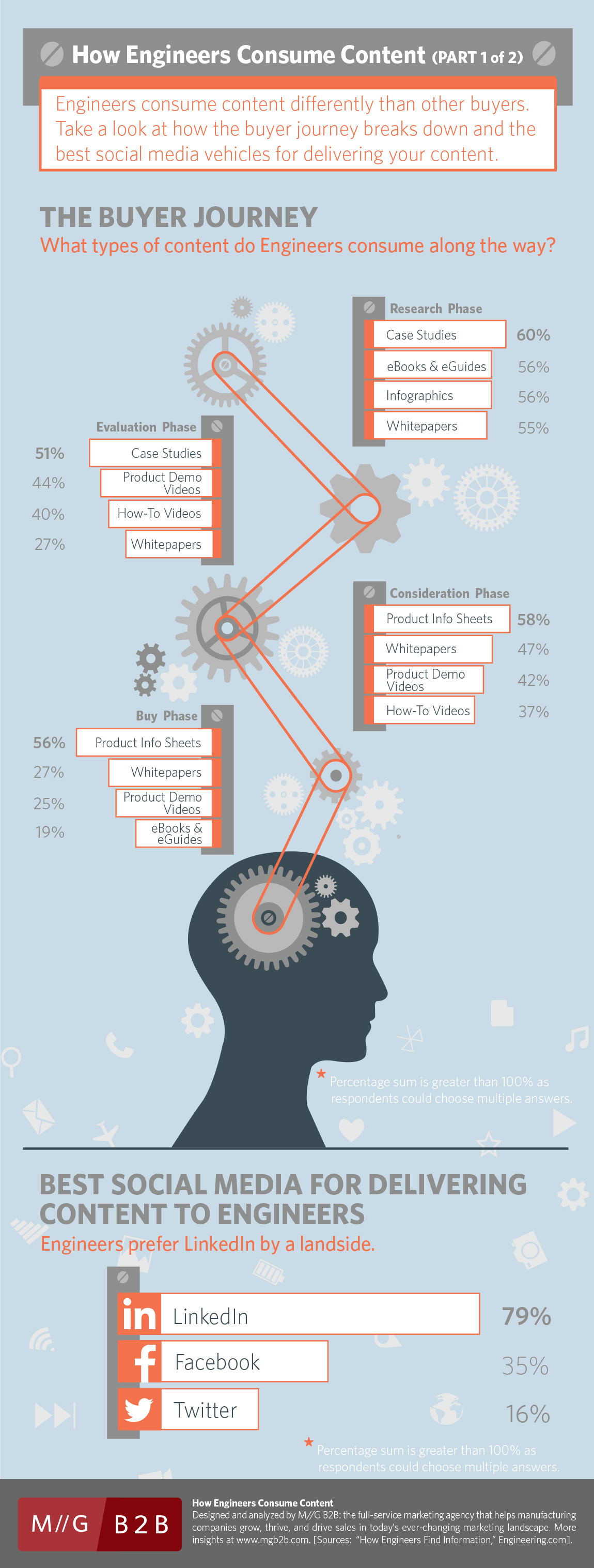by MGB2B

The Myth: LinkedIn Is Just for New Hires
The Truth: LinkedIn Can Generate Leads and Position Your Brand as a Thought Leader
LinkedIn’s abilities go far past finding new hires, and B2B brands should begin to use it more effectively. What you may not know is that LinkedIn can help generate leads and position your brand as a thought leader within your industry. According to the Content Marketing Institute, 97% of B2B marketers use LinkedIn for content marketing. LinkedIn has proven itself to be more than a networking platform, especially for B2B marketers. Visitors aren’t only looking for job listings. In fact, most of them are looking at content to help them improve at their jobs. So if you want to be a step ahead of competitors, LinkedIn is a good place to start.
Here Are 3 Ways B2B Brands Can Use LinkedIn More Effectively:
- Be Active in Industry Groups. LinkedIn is a great platform to target people and companies based on industry. It allows your company to connect with people who have similar interests. This makes finding people who might be interested in your product easier. LinkedIn offers a variety of groups and ranks them based on activity. Find a relevant and active group to join and get involved with others. Joining an active group is ideal because more people will interact with your posts. It’s important to be active in the groups that you join. Being a part of groups that are relevant to your industry will help your company form relationships that can transform into leads and customers.
- Become a Thought Leader. Thought leadership is a valuable asset because it gives your brand authority within your industry. If you’re a thought leader, people will be more likely to trust your company and the information you share. Most people will base their first impression on of your company profile, so make sure that it’s engaging and reflects your brand’s unique qualities. Develop a memorable headline that shows people why they should want to do business with you. Get involved in existing conversations and start some of your own. Share relevant and valuable information. And most important – create some of your own. Creating content and sharing it on LinkedIn not only allows you to establish your brand as a thought leader, but also drives users to your website.
- Generate Leads with Sponsored Content. In 2017 LinkedIn introduced a feature called Lead Gen Forms. When used with the platform’s Sponsored Content program, the quality of leads and ease of capturing them increases tremendously. Personal information is pre-filled because it comes from the member’s LinkedIn Profile, so the data is reliable. Plus, Lead Gen Forms make it easy to track and calculate your ROI. LinkedIn makes advertising to the right prospects simple, accurate, and highly targeted.
B2B Marketers often overlook how useful LinkedIn can be to their brand. Just being on LinkedIn is important, but when used correctly, it can open up a wealth of opportunities. With over 500 million members to interact and engage with, generating highly qualified leads might be easier than you think.
Continue Reading
by MGB2B

Ever want to see inside the mind of an engineer? If you run the marketing department of a manufacturing company, the answer is probably a resounding “yes.”
This infographic – Part 1 of a 2-part series – takes a look at how engineers approach content. In particular, it explores which content they consume during the Buyer Journey and where they consume it. You’ll see how the Journey is broken down into four phases: Research, Consideration, Evaluation, and Buy. And content is consumed differently in each phase.
It’s likely no surprise that Case Studies are consumed more heavily in an engineer’s decision-making process earlier in the Buyer Journey. Or that Product Info Sheets are more influential later in the process.
But it’s worth noting how different types of video work better in different phases. And just how much engineers prefer LinkedIn over other social platforms. Take a look at the full infographic to get a better look at the engineer’s decision-making process. It will give you great insights as you fine-tune your Content Marketing Plan in the second and third quarters of 2018.
Read the Full Infographic on How Engineers Consume Content Below:
(And stay tuned for Part 2… coming soon.)

Continue Reading
by MGB2B

The Myth: B2B Companies Don’t Need a Brand Voice
The Truth: The Tone and Style of Your Brand Voice Differentiates You From Your Competition
It’s easy for B2B companies to overlook the importance of creating a brand voice. Many companies forget that they are selling to real humans who are emotionally engaged when making buying decisions – even in the B2B world. Because of this, content can often be full of jargon and technical terms. This type of content clouds your brand’s personality and leaves customers confused about what they can gain from using your product or service. This problem can be solved by developing a B2B brand voice just for your company.
A brand voice includes personality, tone, and attitude and allows you to differentiate your business from competitors. Developing a brand voice might seem like a daunting task, but it’s likely that one already exists within your company; it just needs to be uncovered.
Here Are 3 Reasons Why Your Company Needs to Develop a Cohesive Brand Voice:
- A Brand Voice Connects You with Your Audience. In order to ensure your voice resonates with your audience, you first have to understand who they are. This may require a bit of research into your current customers. Once you know exactly who your audience is and what they want from you, developing your voice will be easier. Is your brand more professional, or are you bold and witty? Tailoring your voice to your specific audience helps develop content that buyers relate to. B2B buyers are humans after all, and they want to purchase from brands who they believe are genuine and trustworthy.
- It Differentiates You from Competitors. Your voice should be unique and make your company stand out. A great place to start is by identifying values that are important to your company and using them to shape your brand voice. If you stay authentic to your brand, buyers will remember you over the competition. Look to companies such as MailChimp, who have successfully distinguished their voice and personality. To create a successful brand voice, your company needs to be aware of what your competition is doing. For example, if your competitors use a boring or dry voice, adding a little bit of humor or conversational tone can attract buyers to your product.
- It Encourages Consistency Throughout the Entire Company. Consistency is key when it comes to developing your brand voice. In an ideal world, your audience should be able to recognize your content before seeing your company name attached to it. Your voice should be clear across all platforms: blogs, social media, websites, emails, and more. If your voice lacks consistency, it can create confusion and disconnect between your brand and customers. Inconsistency can also lead to confusion among sales and marketing teams. One way to ensure your brand voice remains consistent is by creating a style guide that employees can reference.
Developing a brand voice is not a one-time thing. It’s important to maintain your voice over time and keep up with industry changes while remaining consistent and authentic. Help your brand remain relevant by keeping up with your audience and competitors. A well-developed brand voice will generate interest among buyers and, most importantly, keep you a step (or ten) ahead of the competition.
Continue Reading



